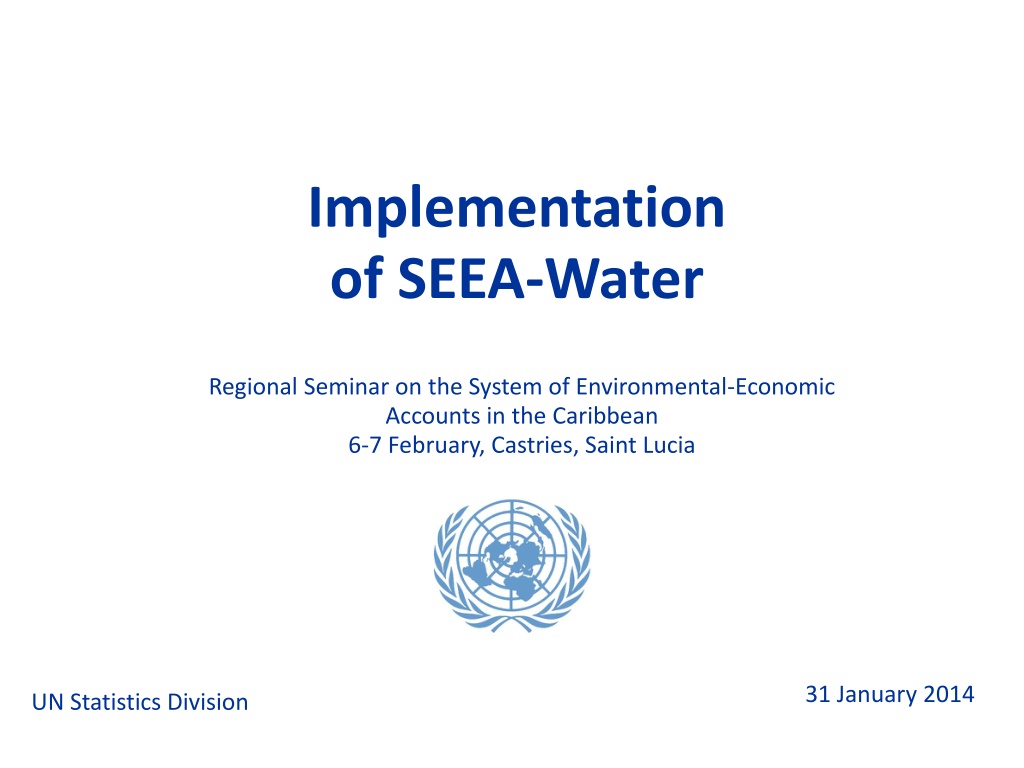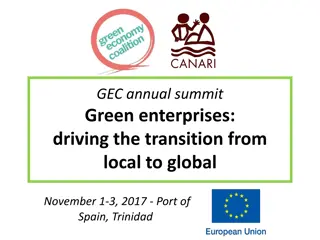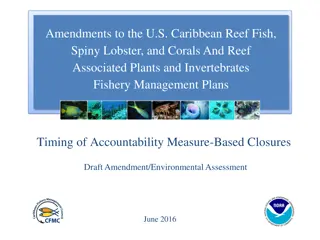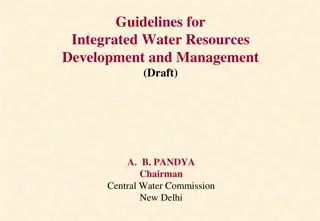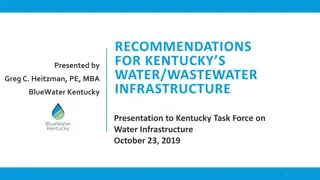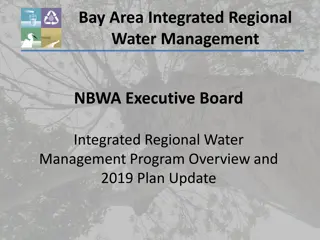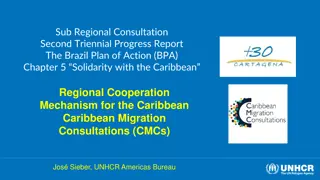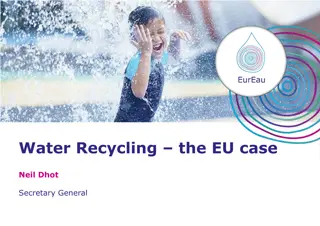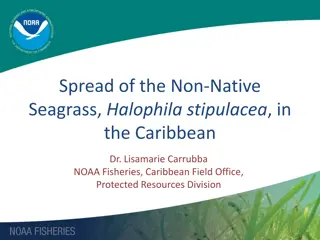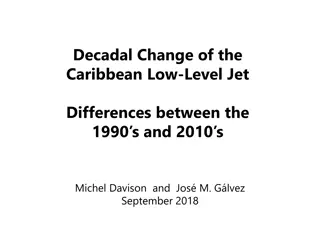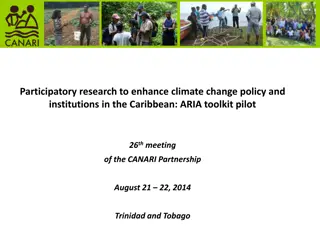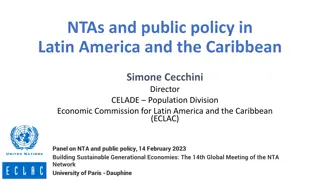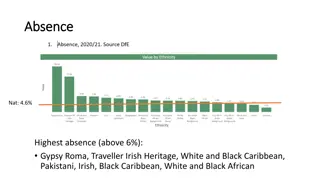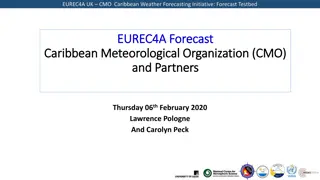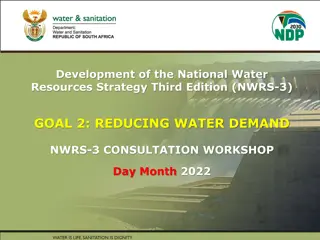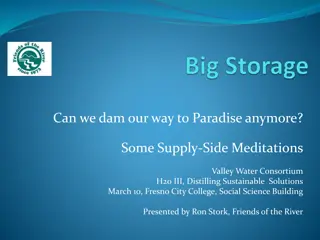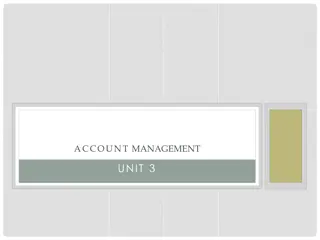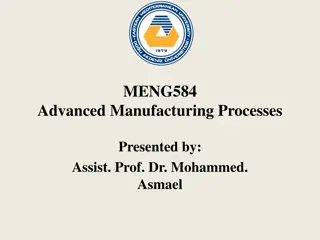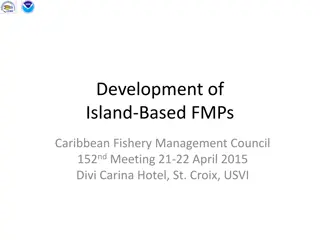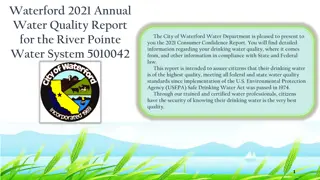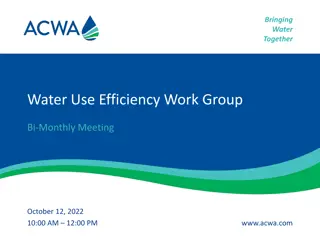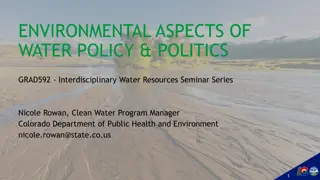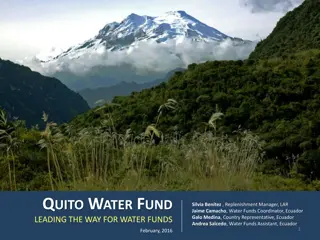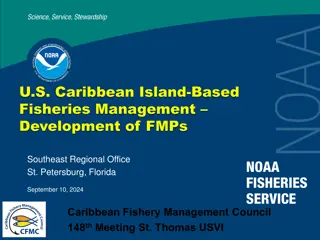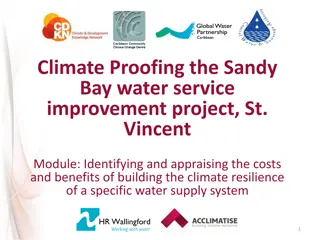System of Environmental-Economic Accounts for Water Management in the Caribbean
This seminar focused on implementing the SEEAW to address water-related challenges in the Caribbean region. It highlighted the importance of measuring progress towards water policy objectives, including water security, supply management, quality improvement, and adaptation to extreme events. The SEEAW model comprises two subsystems - the economy and inland water resources, emphasizing the need for comprehensive, consistent, and comparable data. The International Recommendations for Water Statistics (IRWS) provide further guidance for countries in implementing SEEA-Water.
Download Presentation

Please find below an Image/Link to download the presentation.
The content on the website is provided AS IS for your information and personal use only. It may not be sold, licensed, or shared on other websites without obtaining consent from the author. Download presentation by click this link. If you encounter any issues during the download, it is possible that the publisher has removed the file from their server.
E N D
Presentation Transcript
Implementation of SEEA-Water Regional Seminar on the System of Environmental-Economic Accounts in the Caribbean 6-7 February, Castries, Saint Lucia 31 January 2014 UN Statistics Division
Policy relevant information on water
The SEEA-Water is a subsystem of the SEEA that covers the physical and economic stocks and flows associated with water. It also covers, to some extent, emissions of pollutants and water quality. The International Recommendations for Water Statistics (IRWS) was designed to assist countries in the implementation of SEEA-Water. Guidelines are being developed to provide additional support. The SEEA-Water and the IRWS provide the framework for developing information that is comprehensive, consistent, and comparable through time and space. 3
In general, water policy objectives can be grouped in the following four groups. Water security contributes to the attainment of higher level objectives. I. Improving drinking water and sanitation services II. Managing water supply and demand Water Governance III. Mitigating water resources degradation/ Improving quality of water resources IV. Adapting to extreme hydro-meteorological events SEEA-Water and IRWS respond to the need of measuring progress towards the attainment of the objectives in the four groups. 4
The SEEA-Water is based on a model made of two subsystems: the economy and inland water resources. (Not all flows are shown in the figure). Atmosphere Rest of the World Economy Rest of the World Economy Precipitation Imports Economy Exports Abstraction Evapo- transpiration Returns Outside territory of reference Outside territory of reference Inland Water Resource System Sea Sea
The model in more detail. (Not all flows are shown). transpiration Atmosphere Evapo- Rest of the World Economy Precipitation Other industries (incl. Agriculture) Households Rest of the World Economy Imports Return Water supply Sewerage Exports Economy Abstraction Return Abstraction Outside territory of reference Outside territory of reference Soil water Surface water Inflows Outflows Groundwater Inland Water Resource System Sea Sea 6
The SEEA provides a framework for transforming sectoral data into integrated policy-relevant information. Sectoral Data Integrated information An integrated picture provides the basis for understanding the different ramifications in the decision-making process. 7
The data required is usually incomplete, but provides elements for developing an integrated picture. Sectoral Data Integrated information Integrating sectoral data for generating information starts a virtuous cycle for data improvement. 8
Statistics Mauritius, in partnership with the Water Resources Unit (WRU), the Central Water Authority (CWA) and the Wastewater Management Authority (WWMA) developed a draft first edition of water accounts. The accounts integrate all the policy relevant information about water in one single document: water supply and sanitation, water resources management, waterborne pollution, floods and droughts The SEEA-Water and the IRWS provided the methodological basis for integrating a wide range of information from different sources. 10
The accounts provide a birds eye view of the water flows in the economy of Mauritius. The data available is organized in order to provide a coherent message . All data available were integrated to create a complete picture. Gaps were identified, and more detail will be added as needed. 11
The accounts are also a useful tool for integrating information about the natural water cycle. Simplified natural water cycle of Mauritius. diagram of the Even a simplified version of the accounts using the scarce data available is useful for developing a comprehensive, comparable and consistent picture of the water cycle, useful for policy design and evaluation. 12
From the accounts different time series can be produced and trends are identified using comparable information. A wide variety of indicators can be developed based on standardized definitions. 13
The SEEA-Water provides the basis for standardizing not only physical information, but also monetary data about water. Monetary information is compatible with national accounts information. 14
Monetary interrelationships of economic decisions and environmental impact. and physical data are seamlessly combined to understand Indicators can be tailored for specific policy concerns having an impact in a whole variety of issues. 15
A cycle of continuous improvement
Countries implementing water accounts develop a self reinforcing loop in which better information creates the demand for better data, and in turn better data can generate better information. Policy design Implementation Monitoring (National Statistical System) The virtuous cycle of continuous improvement is developed at sub-national, national and international levels. 17
Preliminary core tables and accounts for water
Reasons and mandate Core tables provide concise, highly relevant information Information is key to deriving indicators and aids in developing evidence based public policies UNSC at its 44thsession urged UNCEEA to develop a core set of tables and accounts Water is a key resource; there is a high demand from many developed and developing countries for water accounts Two core water tables are proposed
Building blocks to table 1 Core table 1 is composed of 3 major blocks First block shown below contains information on physical supply and use of water Information is part of the physical supply and use table for water which contains more details Codes correspond to data items from IRWS Actual final consumption Industries (by ISIC categories) Rest of the world Taxes less subsidies on products, trade and transport margins Capital Formation ISIC 01- 03 ISIC 05-33, 41-43 ISIC 35 ISIC 36 ISIC 37 ISIC Total industry Government Households 38,39, 45- 99 Total 6. Supply of water (Millions m3) Supply of water to other economic units F+H F H I E+G E E.a G F+H F H I E+G E E.a G F+H F H I E+G E E.a G F+H F H I E+G E E.a G F+H F H I E+G E E.a G F+H F H I E+G E E.a G F+H F H I E+G E E.a G G.2+G.4 G.2+G.4 F+H+G2+G4 F+G2+G4 H I E+G+F.2+F.4 E E.a G+F.2+F.4 Total returns Losses 7. Use of water (Millions m3) Total Abstraction F.2+F.4 of which: Abstraction for own use Use of water received from other economic units F.2+F.4
Building blocks to table 1 Second block shown below contains information on supply and use for water products in monetary terms Information is part of the monetary supply and use table for water which contains more details National accounts data can be used to populate table to the extent possible Actual final consumption Industries (by ISIC categories) Rest of the world Taxes less subsidies on products, trade and transport margins Capital Formation ISIC 01- 03 ISIC 05-33, 41-43 ISIC 35 ISIC 36 ISIC 37 ISIC Total industry Government Households 38,39, 45- 99 Total 1. Supply of water products (Currency units) M.1.1.1- L.1.1+M.1.1.1- [N.1.1.1+N.1.2.1] [N.1.1.1+N.1.2.1] Natural water L.1.1 L.1.1 L.1.1 L.1.1 L.1.1 L.1.1 L.1.1 M.1.1.2- L.1.2+M.1.1.2- [N.1.1.2+N.1.2.2] [N.1.1.2+N.1.2.2] Sewerage services 3. Intermediate consumption and final use (Currency units) Natural water L.1.2 L.1.2 L.1.2 L.1.2 L.1.2 L.1.2 L.1.2 L.4 L.5 L.4 L.5 L.4 L.5 L.4 L.5 L.4 L.5 L.4 L.5 L.4 L.5 Sewerage services Other products 4. Gross value added (Currency units)
Building blocks to table 1 Third block contains monetary information on water related assets Information is relevant for a more complete understanding of the investment needs in the water sector Actual final consumption Industries (by ISIC categories) Rest of the world Taxes less subsidies on products, trade and transport margins Capital Formation ISIC 01- 03 ISIC 05-33, 41-43 ISIC 35 ISIC 36 ISIC 37 ISIC Total industry Government Households 38,39, 45- 99 Total 8. Gross fixed capital formation (Currency units) For water supply For water sanitation 9. Closing Stocks of fixed assets for water supply (Currency units) P.1.1 P.1.2 O.1.1 O.1.2 P.1.1 P.1.2 O.1.1 O.1.2 P.1.1 P.1.2 O.1.1 O.1.2 P.1.1 P.1.2 O.1.1 O.1.2 P.1.1 P.1.2 O.1.1 O.1.2 P.1.1 P.1.2 O.1.1 O.1.2 P.1.1 P.1.2 O.1.1 O.1.2 P.1.1 P.1.2 O.1.1 O.1.2 10. Closing Stocks of fixed assets for water sanitation (Currency units)
Core table 1-putting it all together Actual final consumption Industries (by ISIC categories) Rest of the world Taxes less subsidies on products, trade and transport margins Capital Formation ISIC 01- 03 ISIC 05-33, 41-43 ISIC 35 ISIC 36 ISIC 37 ISIC Total industry Government Households 38,39, 45- 99 Total 1. Supply of water products (Currency units) M.1.1.1- L.1.1+M.1.1.1- [N.1.1.1+N.1.2.1] [N.1.1.1+N.1.2.1] Natural water L.1.1 L.1.1 L.1.1 L.1.1 L.1.1 L.1.1 L.1.1 M.1.1.2- L.1.2+M.1.1.2- [N.1.1.2+N.1.2.2] [N.1.1.2+N.1.2.2] Sewerage services 2. Total supply of products 3. Intermediate consumption and final use (Currency units) Natural water L.1.2 L.1.2 L.1.2 L.1.2 L.1.2 L.1.2 L.1.2 L.4 L.5 L.4 L.5 L.4 L.5 L.4 L.5 L.4 L.5 L.4 L.5 L.4 L.5 Sewerage services Other products 4. Gross value added (Currency units) 5. Employment 6. Supply of water (Millions m3) Supply of water to other economic units F+H F H I E+G E E.a G F+H F H I E+G E E.a G F+H F H I E+G E E.a G F+H F H I E+G E E.a G F+H F H I E+G E E.a G F+H F H I E+G E E.a G F+H F H I E+G E E.a G G.2+G.4 G.2+G.4 F+H+G2+G4 F+G2+G4 H I E+G+F.2+F.4 E E.a G+F.2+F.4 Total returns Losses 7. Use of water (Millions m3) Total Abstraction F.2+F.4 of which: Abstraction for own use Use of water received from other economic units 8. Gross fixed capital formation (Currency units) For water supply For water sanitation 9. Closing Stocks of fixed assets for water supply (Currency units) F.2+F.4 P.1.1 P.1.2 O.1.1 O.1.2 P.1.1 P.1.2 O.1.1 O.1.2 P.1.1 P.1.2 O.1.1 O.1.2 P.1.1 P.1.2 O.1.1 O.1.2 P.1.1 P.1.2 O.1.1 O.1.2 P.1.1 P.1.2 O.1.1 O.1.2 P.1.1 P.1.2 O.1.1 O.1.2 P.1.1 P.1.2 O.1.1 O.1.2 10. Closing Stocks of fixed assets for water sanitation (Currency units) 11. Water consumption (Millions m3)
Core table 1 Countries can start by compiling information that is most policy relevant and focus on the any of building blocks to core table 1 if information on other building blocks is not readily available Core tables are flexible in that if more detailed information is required, rows/columns can be further disaggregated as necessary.
Core table 2 Physical flows of water from/to environment Part of the physical asset account for water Focus on changes in stocks Type of water resource Surface water Total Groundwater Soil water Artificial reservoirs H.1.1.1 Lakes Rivers and H.1.1.3 Glaciers, snow and ice Additions to stock Returns Precipitation Inflows from other territories Inflows from other inland water resources Discoveries of water in aquifers H.1.1.2 H.1.1.4 H.1.2 H B.1 B.2 B.1 B.2 B.1 B.2 B.1 B.2 B.1 B.2 D B.2 Reductions in stock Abstraction E.1.1.1 E.1.1.2 E.1.1.3 E.1.1.5 E.1.2 E.1.3 E.1 E.a.a E.a.e C.1 C.2.1 C.2.2 for hydro power generation for cooling water Evaporation & actual evapotranspiration Outflows to other territores Outflows to the sea Outflows to other inland water resources C.1 C.1 C.1 C.1 C.2.1 C.2.2 C.2.1 C.2.2 C.2.1 C.2.2 D
Indicators Core tables contain the necessary information for deriving numerous indicators on water Total renewable water resources Total abstractions by industry Intensity of use of water resources Water productivity/intensity indicators Investments in water infrastructure
Thank you! Ivo Havinga (havinga@un.org)
